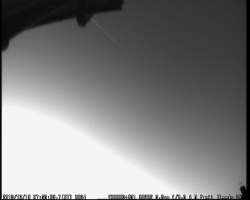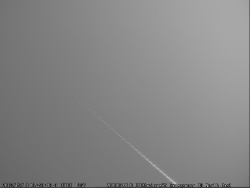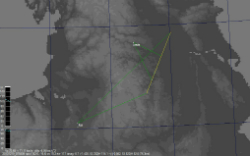Welcome to NEMETODE
Network for Meteor
Triangulation and Orbit Determination
Bright Meteor of 19th December 2013 at 07:58:09 GMT
At 07:58 GMT on 19th December 2013 a bright meteor was observed over the UK - reports soon started to appear on Twitter (initial consolidated list here) and on the Armagh Fireball Report Page. Most meteor cameras across the UK had by this time shut down due to the imminent sunrise but NEMETODE cameras operated by Alex Pratt in Leeds and William Stewart in Ravensmoor were still operating and captured the early stages of the event. Alex's camera commenced automatic shutdown 71 seconds after the meteor occurred!
The videos are shown below as is the triangulated ground track. Single station analysis from Ravensmoor suggested this meteor was a December Chi Virginid though dual station analysis indicates that it was a sporadic. Note that the Ravensmoor camera has been rotated clockwise through 90 degrees within its housings in order to minimise local overlap (see Nodes) and so what appears to be the bottom of the field of view is actually the left hand side.
From an analysis of the NEMETODE data, the maximum magnitude was -0.7 however the meteor was continuing to brighten as it exited the field of view of both cameras and hence the maximum magnitude achieved and the extent to which the meteor continued beyond the end of the shown ground track cannot be determined from the videos. The visual reports suggest that it was sufficiently bright to be classed as a fireball while some reports suggest that it was still visible as it passed over the coastline and out into the North Sea.
Further analysis to follow. In the meantime visual observers are strongly encouraged to submit their reports to the Armagh Fireball Report Page. Of particular interest will be the observer's location, the cardinal direction at which the meteor faded to invisibility, the angle above the horizon at which it faded to invisibility and an estimate of the maximum brightness of the meteor in comparison to, for example, the Moon or Venus. While the videos provide good information relating to the start of the meteor trail, the visual reports will be essential in determining the maximum brightness and whether or not the meteor did indeed pass over the coast and out to sea.
Clicking on the image of the meteor itself will download / play a .wmv file of the event itself. Details of the date, time and location are shown in the text at the bottom of each video clip. In addition, we've also included images of the derived ground track and orbit. |
|||
All images and videos are available for individual personal use. The copyright resides with the authors and their written permission must be obtained in advance of any public and / or commercial use. |
|||


